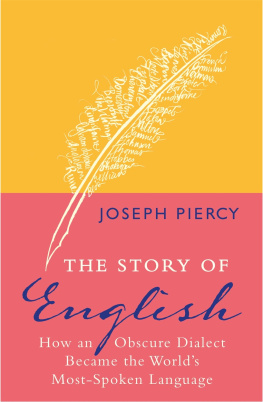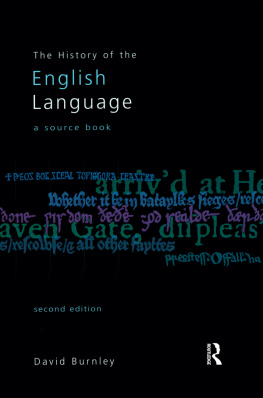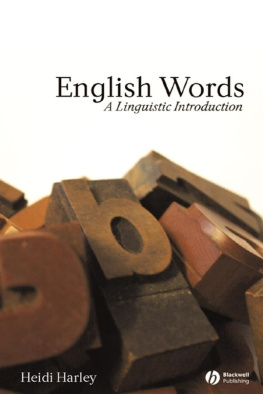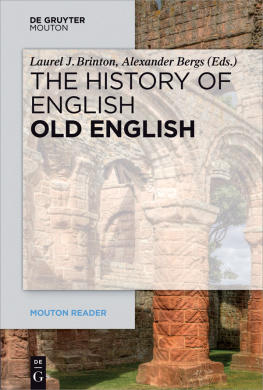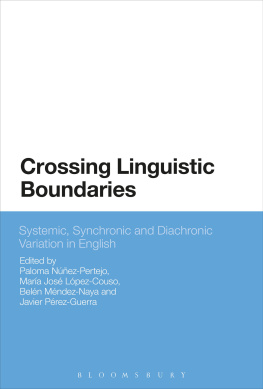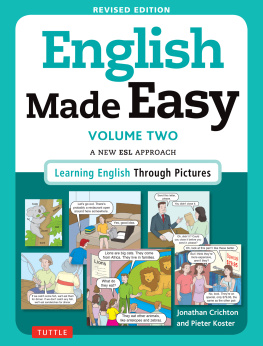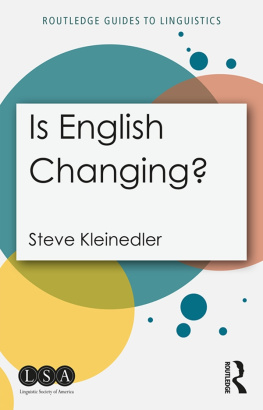Table of Contents
TEXTBOOKS IN ENGLISH LANGUAGE AND LINGUISTICS (TELL)
Edited by Magnus Huber and Joybrato Mukherjee
VOLUME 6
Thomas Kohnen
Introduction to the History of English
Bibliographic Information published by the Deutsche Nationalbibliothek
The Deutsche Nationalbibliothek lists this publication in the Deutsche Nationalbibliografie; detailed bibliographic data is available in the internet at http://dnb.d-nb.de.
Library of Congress Cataloging-in-Publication Data
Kohnen, Thomas, 1956
Introduction to the history of English / Thomas Kohnen. -- Peter Lang Edition.
pages cm. -- (Textbooks in English Language and Linguistics ; Volume 6)
Includes bibliographical references.
ISBN 978-3-631-56004-4 -- ISBN 978-3-653-04171-2 (E-book) 1. English language--History. 2. English language- Middle English, 1100-1500. 3. English language--Early modern, 1500-1700. 4. Historical linguistics. I. Title.
PE1075.K585 2014
420.9--dc23
2013049721
ISSN 1862-510X
ISBN 978-3-631-56004-4 (Print)
E-ISBN 978-3-653-04171-2 (E-Book)
DOI 10.3726/ 978-3-653-04171-2
Peter Lang GmbH
Internationaler Verlag der Wissenschaften
Frankfurt am Main 2014
All rights reserved.
Peter Lang Edition is an Imprint of Peter Lang GmbH.
Peter Lang Frankfurt am Main Bern Bruxelles New York Oxford Warszawa Wien
All parts of this publication are protected by copyright. Any utilisation outside the strict limits of the copyright law, without the permission of the publisher, is forbidden and liable to prosecution. This applies in particular to reproductions, translations, microfilming, and storage and processing in electronic retrieval systems.
This book is part of the Peter Lang Edition list and was peer reviewed prior to publication.
www.peterlang.com
About the author(s)/editor(s)
Thomas Kohnen is Professor of English historical linguistics at the University of Cologne. His major fields of study include historical pragmatics and historical text linguistics, corpus linguistics, historical syntax, speech act theory as well as orality and literacy and the language of religion.
About the book
This book is written for students of English who are interested in the history of the language and would like to read an accessible but also comprehensive and reasonably detailed introduction. Apart from basic information about language change and the Indo-European background of English, it gives an outline of the major periods of the language (Old English, Middle English, Early Modern English and Late Modern English), with a brief examination of the perspectives of present-day English. Each period chapter provides information about the socio-historical background, the core areas of linguistic structure, discourse, speech acts and genres, and concludes with study questions and exercises.
This eBook can be cited
This edition of the eBook can be cited. To enable this we have marked the start and end of a page. In cases where a word straddles a page break, the marker is placed inside the word at exactly the same position as in the physical book. This means that occasionally a word might be bifurcated by this marker.
| v
Preface
This book aims to provide an accessible but also comprehensive and reasonably detailed introduction to the history of the English language. After a short overview of the basic facts of language change and the Indo-European background of English, it traces the major periods of the language (Old English, Middle English, Early Modern English and Late Modern English), with a brief examination of the perspectives of present-day English. Each period chapter follows the same pattern, providing information about the socio-historical background and the core areas of linguistic structure, but also about discourse, speech acts and genres. The text is richly illustrated with examples and text excerpts, and each chapter concludes with a section containing study questions and exercises.
I would like to thank Tanja Rtten for her feedback on the manuscript. I would also like to thank Stefanie Leu, who designed the maps and figures, and Kirsten Gather, Leonie Mohr and Christina Rath for their help with the manuscript.
Cologne
November 2013
Thomas Kohnen
| 1
Language is continually changing. Some people may not be aware of this fact, since language change is often slow and hardly perceptible. Probably, innovation will become most noticeable in the field of lexis, when new words are coined to designate new ideas, facts or activities. A few decades ago, nobody would have used the verbs google or download in the sense that is quite common for us in the year 2013. In the same way, hundreds or even thousands of new words have been added to the English language in the past fifty years. But language change also affects spelling, pronunciation, grammar and language use, and here it may be more difficult to actually observe change in the period of a lifetime. In fact, many people will be convinced that the English they use every day is basically immutable as regards its grammatical structure and pronunciation. However, this is far from correct. In the course of its history, English has undergone quite dramatic changes, but in order to see and appreciate them we must go back five hundred or even one thousand years and look at the texts which have come down to us.
Below are two short extracts which may illustrate some of these changes. The first text excerpt (example 1) stems from the second half of the tenth century, that is, from the Anglo-Saxon period. Anglo-Saxon or Old English is often called a form of English which is mainly incomprehensible to most native speakers of English without special instruction, but it is still English and not a foreign language. Thus, it can illustrate many of the sweeping changes which English has undergone in its history. The text is a preface to a translation of parts of the Bible. The author, lfric, was one of the most prolific writers of the Anglo-Saxon period, and he chose for his preface the form of a letter. The letter is addressed to his patron, thelwrd, who commissioned the translation. thelwrd was an ealdorman, that is, a nobleman exercising authority under the king.
(1) LFRIC MUNUC GRET ELWRD EALDORMANN EADMOdlice.
lfric monk greets thelwrd alderman/ ruler humbly
u bde me, leof, t ic sceolde e awendan of Lydene on Englisc a boc
you asked dear that I should (for) you translate from Latin into English the book
Genesis: a uhte me hefigtime e to tiienne s,
then (it) seemed to me arduous (to) you to grant that
1 | 2
lfric, the monk, greets alderman thelwrd humbly.
You asked me, dear, to translate (that I should translate) for you the book Genesis from Latin into English. Then it seemed to me an arduous task to grant you this
(lfric, Preface to Genesis; late 10th century; DOEC)
I am sure this short extract will appear quite foreign to most uninitiated readers. But the glossing, together with the translation, will perhaps help to make the text a little bit more transparent.
Spelling is among the features of the above text which seem to contribute most to its unfamiliar look. We find unusual letters, for example, and (called ash). They represent the Modern English vowel in words like cat and rat. Other letters no longer in use are (called thorn) and (called eth). They both represent Modern English // and //, that is, the initial consonants in



